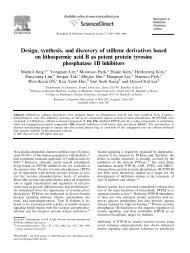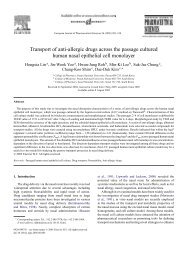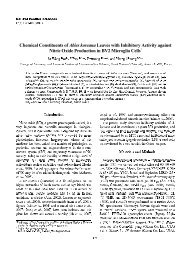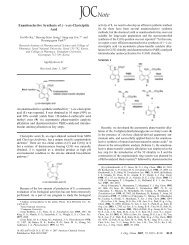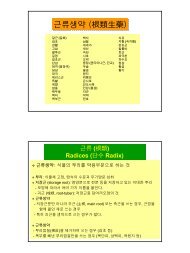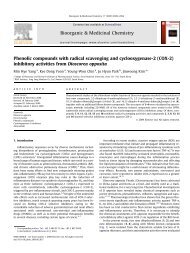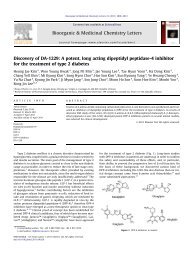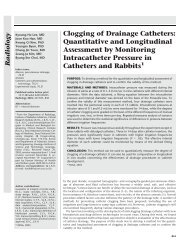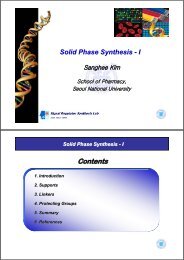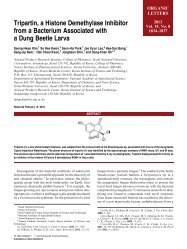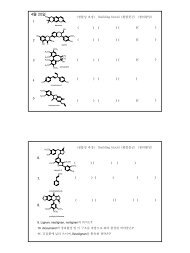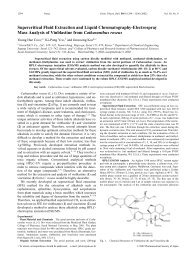Chapter 2 Water
Chapter 2 Water
Chapter 2 Water
You also want an ePaper? Increase the reach of your titles
YUMPU automatically turns print PDFs into web optimized ePapers that Google loves.
14<br />
<strong>Chapter</strong> 2 <strong>Water</strong><br />
<strong>Chapter</strong> 2 <strong>Water</strong> 15<br />
Page: 56 Difficulty: 2 Ans: E<br />
The pH of a sample of blood is 7.4, while gastric juice is pH 1.4. The blood sample has:<br />
A) 0.189 times the [H + ] as the gastric juice.<br />
B) 5.29 times lower [H + ] than the gastric juice.<br />
C) 6 times lower [H + ] than the gastric juice.<br />
D) 6,000 times lower [H + ] than the gastric juice.<br />
E) a million times lower [H + ] than the gastric juice.<br />
11. Ionization of water, weak acids, and weak bases<br />
Page: 57 Difficulty: 1 Ans: D<br />
The aqueous solution with the lowest pH is:<br />
A) 0.01 M HCl.<br />
B) 0.1 M acetic acid (pK a = 4.86).<br />
C) 0.1 M formic acid (pK a = 3.75).<br />
D) 0.1 M HCl.<br />
E) 10 –12 M NaOH.<br />
12. Ionization of water, weak acids, and weak bases<br />
Page: 57 Difficulty: 1 Ans: D<br />
The aqueous solution with the highest pH is:<br />
A) 1 M HCl.<br />
B) 1 M NH 3 (pK a = 9.25).<br />
C) 0.5 M NaHCO 3 (pK a = 3.77).<br />
D) 0.1 M NaOH.<br />
E) 0.001 M NaOH.<br />
13. Ionization of water, weak acids, and weak bases<br />
Page: 57 Difficulty: 2 Ans: B<br />
Phosphoric acid is tribasic, with pK a ’s of 2.14, 6.86, and 12.4. The ionic form that predominates at pH<br />
3.2 is:<br />
A) H 3 PO 4 .<br />
B) H 2 PO 4 – .<br />
C) HPO 4 2– .<br />
D) PO 4 3– .<br />
E) none of the above.<br />
14. Buffering against pH changes in biological systems<br />
Page: 59-60 Difficulty: 2 Ans: E<br />
Which of the following statements about buffers is true<br />
A) A buffer composed of a weak acid of pK a = 5 is stronger at pH 4 than at pH 6.<br />
B) At pH values lower than the pK a , the salt concentration is higher than that of the acid.<br />
C) The pH of a buffered solution remains constant no matter how much acid or base is added to the<br />
solution.<br />
D) The strongest buffers are those composed of strong acids and strong bases.<br />
E) When pH = pK a , the weak acid and salt concentrations in a buffer are equal.<br />
15. Buffering against pH changes in biological systems<br />
Page: 59-61 Difficulty: 3 Ans: D<br />
A compound has a pK a of 7.4. To 100 mL of a 1.0 M solution of this compound at pH 8.0 is added 30<br />
mL of 1.0 M hydrochloric acid. The resulting solution is pH:<br />
A) 6.5<br />
B) 6.8<br />
C) 7.2<br />
D) 7.4<br />
E) 7.5<br />
16. Buffering against pH changes in biological systems<br />
Page: 60-61 Difficulty: 2 Ans: E<br />
The Henderson-Hasselbalch equation:<br />
A) allows the graphic determination of the molecular weight of a weak acid from its pH alone.<br />
B) does not explain the behavior of di- or tri-basic weak acids<br />
C) employs the same value for pK a for all weak acids.<br />
D) is equally useful with solutions of acetic acid and of hydrochloric acid.<br />
E) relates the pH of a solution to the pK a and the concentrations of acid and conjugate base.<br />
17. Buffering against pH changes in biological systems<br />
Page: 60–61 Difficulty: 2 Ans: D<br />
Consider an acetate buffer, initially at the same pH as its pK a (4.76). When sodium hydroxide (NaOH)<br />
is mixed with this buffer, the:<br />
A) pH remains constant.<br />
B) pH rises more than if an equal amount of NaOH is added to an acetate buffer initially at pH 6.76.<br />
C) pH rises more than if an equal amount of NaOH is added to unbuffered water at pH 4.76.<br />
D) ratio of acetic acid to sodium acetate in the buffer falls.<br />
E) sodium acetate formed precipitates because it is less soluble than acetic acid.<br />
18. Buffering against pH changes in biological systems<br />
Page: 60–61 Difficulty: 3 Ans: C<br />
A compound is known to have a free amino group with a pK a of 8.8, and one other ionizable group with<br />
a pK a between 5 and 7. To 100 mL of a 0.2 M solution of this compound at pH 8.2 was added 40 mL of<br />
a solution of 0.2 M hydrochloric acid. The pH changed to 6.2. The pK a of the second ionizable group<br />
is:<br />
A) The pH cannot be determined from this information.<br />
B) 5.4<br />
C) 5.6<br />
D) 6.0<br />
E) 6.2



